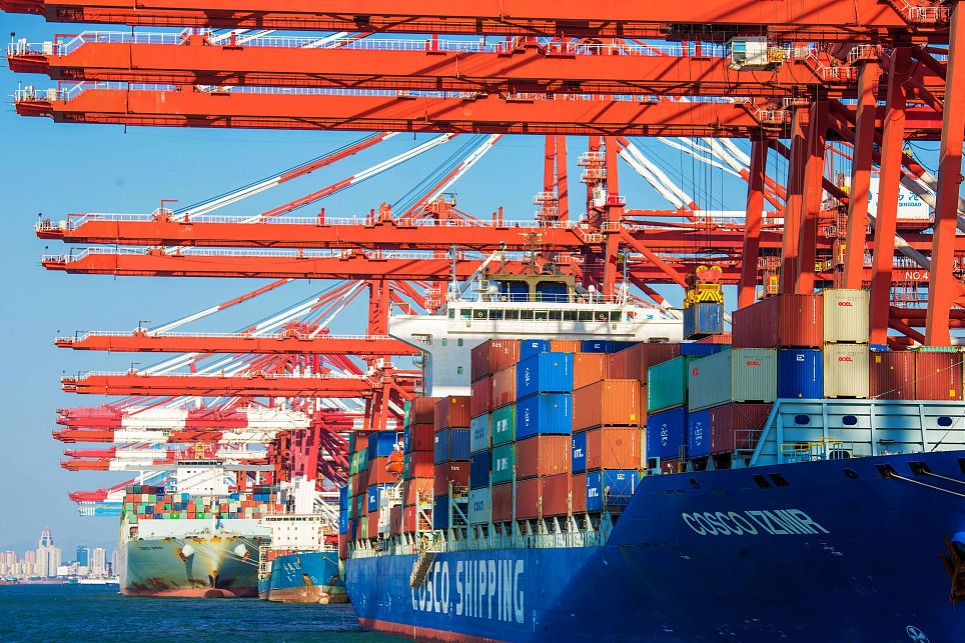China's strong banking sector fears no slander as performance stable
By Sheng Wenwen and Wang Yuan | China Daily | Updated: 2023-11-06 10:02

With deliberate intentions to short China's banking sector, some foreign media outlets and financial institutions made unreasonable assumptions recently without factual basis on the nation's major commercial lenders.
Their comments mainly pointed to so-called issues like risk exposure of local bonds in China's banking sector being too large, and said it is difficult to achieve good capital adequacy ratios, provisional coverage ratios and dividend payout levels simultaneously. Goldman Sachs even downgraded ratings for some banking shares, which raised concerns over the soundness of China's financial system, as some of the lenders concerned play important roles in the country.
Such irresponsible comments and moves, which, as we see things, only function to damage prospects and trigger sharp volatility in banking shares, also exacerbated cross-border capital outflows and renminbi depreciation pressure. We feel the comments have no solid foundation.
Over the past 20 years, the net profit growth of China's commercial banks has stayed steady at around 15 percent — much higher than the profit growth rate of about 3 percent in Europe and the United States. In recent years, in the face of phased pressure on economic growth and various unexpected headwinds like the COVID-19 pandemic, the nation guided the financial system to support the real economy and reduce the comprehensive financing cost of enterprises, which is different from the pro-cyclical credit characteristics of the banking sector in the West, leading to a narrowed net interest margin among lenders — from 2.2 percent in the fourth quarter of 2019 to 1.74 percent in the second quarter of this year. However, in the first half, net profits of China's commercial banks rebounded to 1.3 trillion yuan ($177.7 billion), a year-on-year increase of 2.6 percent. The growth rate accelerated slightly compared with the first quarter, indicating that the performance of banks had already bottomed out.
Additionally, if seen from the perspective of basic financial indicators, the profitability and growth of China's banking sector are still better than those in the West. Since 2022, the global economy has been sluggish, and with interest rates in major developed economies standing high and the aftermath of the banking crisis lingering in some major Western economies, the global banking sector is under pressure. Amid such headwinds, the return on equity of China's banking sector remained as high as 10.8 percent in 2022, slightly lower than the 11.6 percent in the US over the same period, but significantly higher than the 6.3 percent level seen in the eurozone.
According to the Top 1000 World Bank 2023 list released by The Banker, 140 Chinese banks made the list for the second consecutive year. Industrial and Commercial Bank of China topped the list for 11 consecutive years, followed by China Construction Bank, Agricultural Bank of China and Bank of China. These Chinese lenders continued to rank as the top four for the sixth consecutive year.
Large commercial banks in China are operating steadily. In 2022, total assets of the six major banks — Bank of Communications, Postal Savings Bank of China and the above-mentioned four lenders — surged 12.8 percent year-on-year to 164.1 trillion yuan, 5 percentage points higher than that of the same period in the previous year. The scale of new loans exceeded 1 trillion yuan.
China's banking sector has sufficient capacity to offset risks. Judging from the various second-quarter banking regulatory indicators announced by the government, the balance of loan loss provisions by commercial banks was 6.6 trillion yuan, and the provision coverage ratio was 206.13 percent — much higher than the 45.9 percent in the eurozone for 2022. Also, during the same quarter, the capital adequacy ratio of Chinese commercial banks was 14.66 percent, roughly the same as the current figure of 15.3 percent in the US. As of the end of the second quarter, the Tier 1 capital adequacy ratio — which represents the core equity assets of a bank or financial institution — of Chinese commercial banks was 11.78 percent, higher than the average of 8.98 percent in the US banking sector in 2022 despite a downtrend.
The abundant liquidity in China's banking sector tells a similar story. As regulatory rules in the US have no specific requirements for the liquidity coverage ratio and net stable funding ratio of small and medium-sized banks, a large number of small and medium-sized banks, such as Silicon Valley Bank, face high liquidity risks. In stark contrast, China introduced a series of measures in 2018 to impose liquidity requirements on all types of commercial banks. Currently, the liquidity ratio of all commercial banks meets the minimum regulatory requirement of no less than 25 percent. As a result, by the end of the second quarter, the liquidity coverage ratio of Chinese commercial banks was 150.86 percent. Cases similar to SVB are unlikely in China.
Last but not least, the number of financial institutions facing high risks in China has been declining, showing a downtrend in recent years. According to a report released by the People's Bank of China, the country's central bank, among the 4,392 polled institutions in the second quarter of 2022, the number of high-risk institutions had dropped significantly from a peak of 649 in the third quarter 2019 to 366, and total assets of high-risk institutions accounted for only 1.55 percent of total assets in the banking sector. Existing high-risk institutions are all small and medium-sized banks and nonbanking institutions, and the risk rating results of the top four major State-owned commercial banks and joint-stock banks are all within safe parameters.
As a major financial market, China has been optimizing its nonperforming asset management system, and its banking industry is shifting more focus onto credit risk management while ensuring its support for the real economy, so as to prevent and resolve potential nonperforming risks. With such efforts, the overall asset quality of the Chinese banking sector has been improving, and with the further convergence of China's commercial banks' capital supervision and international regulatory rules, its financial supervision will be further improved to boost the progress of bank asset classification and better prevent financial risks.
The writers are researchers at the Academy of Macroeconomic Research under the National Development and Reform Commission.
The views do not necessarily reflect those of China Daily.
























